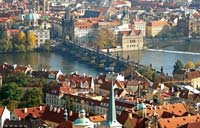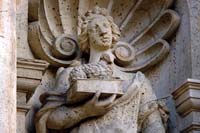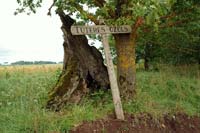Defining the terms "monument" and "heritage"
When searching for unified denomination for those values which society wants to maintain for coming generations we come across different terms, most often - "monument" and "heritage". It is characteristic that both terms in many languages, including English, are used mainly with another meaning.
The word "heritage" most often is used to denominate values belonging to individual or a family to be inherited by the next generation of the family (usually). This term is often referred also to common values of society which also should be inherited by next generations. There exists a borderline between terms "natural heritage" and "cultural heritage". This could be linked to the fact that the governance of nature and culture heritage is set apart in different institutions and normative acts, different people deal with each part of heritage. Even in the cases when both kinds of heritage happen to be under a single umbrella, this definition does not merge into single whole - for example in Convention Concerning the Protection of the World Cultural and Natural Heritage the term "cultural heritage" is defined in Article 1, but "natural heritage" - separately in Article 2. (1) This approach creates problems in monument protection - due to this some values are omitted or identified and protected too scantily.
The word "monument" is associated rather with an object of sculptural art which memorializes a historical event or significant personality. The root of the word contains Latin term "monere" - "to remind/warn" - thus a monument is a place or object having a link to certain event. When looking at monument one can remember and remind this event. Latvian government institutions also use word "monument" but it includes only those objects which have some protection regime. Here it would be worth to remind that here as in most states of the world the state does not protect all values - many are always left "outside". Thus there is no convention on a term which would designate all valuable places and objects although author uses in this website the term "landmark".
One could assume that generally accepted opinion on contents of these terms is only in a process of formation. Within the framework of his activities author is guided with the following definitions where a term "monument" is subordinated to a term "heritage":
- Heritage is a body of values which is considered by society to be worth preserving for future generations. It includes both tangible part of heritage (for example - artworks, architecture monuments, tools, monuments of technique) and intangible part of heritage (for example - traditions, crafts, languages, dance, folklore).
- Monument is an unit of heritage. In this Website monument is a unit of heritage which is pegged to a certain location, for convenience it is substituted with a term of similar meaning - "landmark".
Other terms
It is interesting to look at terms of other languages which designate interesting sites. In English (similar in Afrikaans, Swedish, Luxembourgish) there is term "landmark", which is used also in this website. In Indonesian language there is term "markah tanah", which also means "mark of land". Esperanto has got a term "rekonilo" ("something what makes recogniseable") - it designates some cliché which identifies a place, f.e. Eiffel Tower as a "reconilo" of Paris or macaroni for Italy. In Dutch there exsists a term "trekpleister" ("attraction plaster, spot"), which designates locations which attract tourists.
Problem of border conditions
When dealing with the identification and survey of landmarks it comes to light rather soon that behind this comparatively simple definition there are hidden complicated issues. Below are outlined some:
Separability issue
Whole historical centre of Riga with thousands of buildings could be seen as one landmark. Nearly every one of these buildings also is a landmark. If we choose one these buildings - f.e. St.Peter's church - it again contains a set of monuments. How should be defined such monument as sculptures on the portal of St.Peter's church - as a separate monument, as a fraction of larger landmark (Peter's church) or as a minor fraction of even larger landmark (Historical centre of Riga)?
Another turn of this issue: how many landmarks are there in Gutmana cave? We can set that whole cave with its values is a single landmark. But we could divide it in several landmarks as well: a) cave itself; b) spring in it; c) tales and legends about the cave; d) ancient instricptions on the walls of the cave etc.
Landmark border issue
Tilgali (Vandzene, Kraujas) giant stone is outstanding geological and archaeological monument which is also shaping a cultural landscape. Where are located borders of this landmark? This seemingly simple question is not simple at all. Interest of geologist (especially - petrographer) will end with the outer borders of stone itself. But exactly here starts the archaeological value of the stone - there are found traces of ancient sacrifices around the stone. At a certain distance from the stone (not exactly defined) this value ends. But at certain distance from the stone there becomes apparent the impact on cultural landscape - the enormous stone on a top of smaller hill is unusual, valuable sight for Latvia. If the view will become overgrown with bushes, our children will loose something. So - does it feel simple to set borders of this landmark?
Issue of intangible landmark
In the legend lord of Dundaga castle met a king of gnomes at crossroads near Slitere but the main events took place in Dundaga castle. Legend of Turaida castle about Maija Roze took place in Turaida castle, Gutmana cave and elsewhere. These legends are connected to certain places but who is able to identify - what exactly should be preserved for future generations in connection with these legends? Where are the borders of these landmarks?
Issue of worldliness
Nothing is forever - sooner or later our current monuments of nature and culture will perish. Others will come in their place. Here a seeker and surveyor of landmarks meets another issue. Oak-tree with 5 metres girth is a monument of nature (according to Latvian law). Oak-tree with 3,5 metres girth in future might become a monument - does it mean that it should be protected just like the oak tree with 5 metres circumference? The location of a former oak-tree with a girth of 7 metres is a monument? Similar questions can be asked about any kind of landmarks, not just trees.
Solutions
Author has not found a single solution for these issues, for example such as a more universal definition for landmark which would help in all cases to distinguish landmarks and "non-landmarks" and set certain borders of these landmarks.
But issues can be solved at least partly through separate solutions for each specific case and consequent use of these principles in all similar cases. Thus, for example, in a case of geological landmarks author strives to divide them in defined categores. In a case of Gutmana cave we will have several separate monuments - Gutmana cave, spring of Gutmana cave, outcrop of Gutmana cave, inscriptions in Gutmana cave. I am not separating the cult places from the connected monuments of nature - thus Vandzene stone and cult site of Vandzene stone is seen as a single landmark. Each location of medieval castle is considered to be a separate landmark even if the castle does not exist anymore. Locations of Barocco style apartment houses of Riga suburbs which were burned down in the beginning of 19th century are not considered to be landmarks.
Life is life - each rule gets exceptions. Thus I consider that the recently demolished apartment building on Uzvaras boulevard 2 in the construction plot of National Library is a landmark - may be because I happened to take pictures of it.
References
- Convention Concerning the Protection of the World Cultural and Natural Heritage. Paris, 1972.
- Pāvils G. Latvijas dabas un kultūras pieminekļu datu bāze.
- Pāvils G. Latvijas dabas un kultūras pieminekļu informācijas sistēma. Maģistra darbs. Rīga, 2004.




